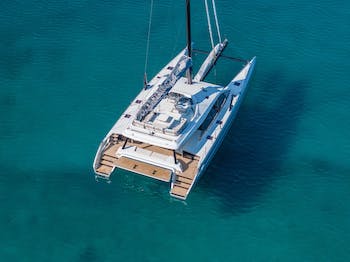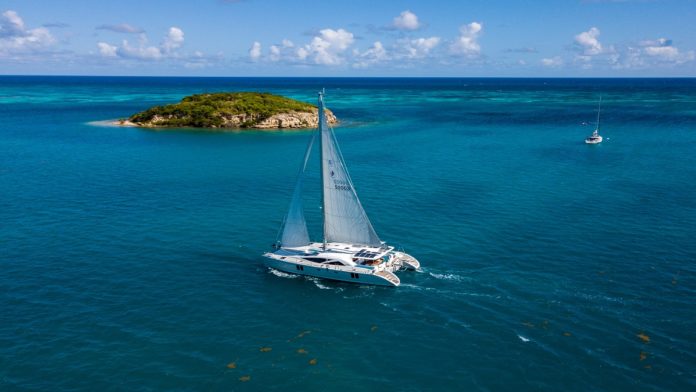
Walking a dock looking at all the sleek power yachts, sailboats, and catamarans, it’s natural to wonder, “just how fast does this thing go?” And whether you’re thinking about buying a boat or just reserving a charter, of all the capabilities of a yacht, speed is the toughest to pin down.
Why? There are a few reasons. First, the environment directly affects your speed, especially in a sailboat. Waves, currents, tides, and wind all affect every yacht. And the effect is different for different classes of yacht as well. Since the environment and how a yacht is used affects speed so much, publishing speeds that are anything more than theoretical may expose boat builders to claims they can’t always support.
Once you have detailed specifications and details for any yacht you look at, you should be able to get an idea just how fast this boat should be able to move in optimal conditions.
Measuring Yacht Speed
The stated speed of a yacht assumes flat water with no wind or current. It is typically expressed in knots (nautical miles per hour) for a sailing vessel, but is may be stated in miles per hour (mph) or even kilometers per hour (kph). The last are more likely for small powerboats and runabouts than large ocean-going yachts, but be prepared to see any of the units to show speed.
Nautical Miles and Knots
The nautical mile (nm or NM) is 6,076 feet, whereas a statute mile is 5,280 feet. So one nm is about 1.15 statute miles, and 1.85 kilometers. The nautical mile serves as the unit of measurement for distance and speed on every ocean, while the statute mile primarily serves on roads in the United States and a few other countries.
Navigators prefer nautical miles because one nautical mile is exactly the same distance as one minute of latitude used to plot positions on charts. This simplifies plotting and navigation. So boat speeds in knots, or nautical miles per hour, are most common for ocean-going yachts.
Use our Sailing Distance calculator here
Motor yacht Speeds
The manufacturer states motor yacht speeds on a curve, graphing engine revolutions per minute against boat speed. This calculation is based on many assumptions, including the engine revolutions, propeller pitch, and hull form, an empty vessel, and flat water.
While useful guidelines for figuring where your cruising RPMs should be, they don’t tell you the absolute maximum a vessel can sustain. Real world performance is often less than the graphed expectation.
Sailing Vessel Speeds
Sailing monohulls and catamarans with auxiliary engines have two different speeds – sailing speed, and motoring speed. The motoring speed estimates are like power yachts. But the sailing speeds are much more complex, because wind strength and direction causes great variability in boat performance. And you can’t sail directly upwind, so upwind speed is more a combination of how fast the boat moves and how close to the wind a yacht sails. Sailors consider upwind sailing speed based on the “made good” speed towards an upwind destination, which you cannot sail straight for.
For sailing speeds, the yacht designer uses a Velocity Prediction Program (VPP) to produce a table of wind angles, wind speeds, and expected hull speeds for those conditions. When plotted on a grid, sailors refer to this graphical representation as a polar diagram (see below). This used to predict how your yacht should sail over a range of wind conditions.
It is still just a prediction, and everything from the waves and sea state to how much baggage, water and fuel you’re carrying can affect it.
Read also: 8 Gulets, Ketch And Schooners To Consider For A Timeless Sail
What determines yacht speed?
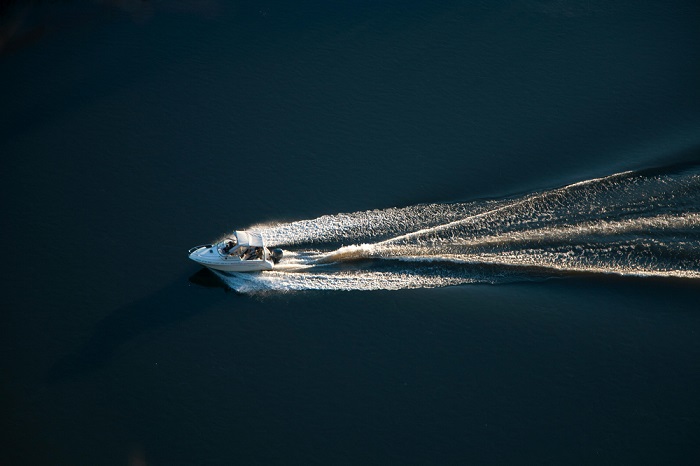
When a designer is drafting a yacht, they’re considering many factors in the design brief. Comfort and space, passenger needs, planned uses for the vessel, cruising ranges, build budgets, and many other requirements go into the design choices of a yacht. All of them, including speed, are a tradeoff against the other factors. Building the fastest yacht possible always compromises some other areas, like comfort, cargo and passenger space, or range.
So which of these factors makes a yacht fast? To some degree, all of them. So it’s important to understand the design criteria and choices to help you pick a boat which meets your needs for comfort and speed.
Hull Form – Displacement vs. planing hull shapes
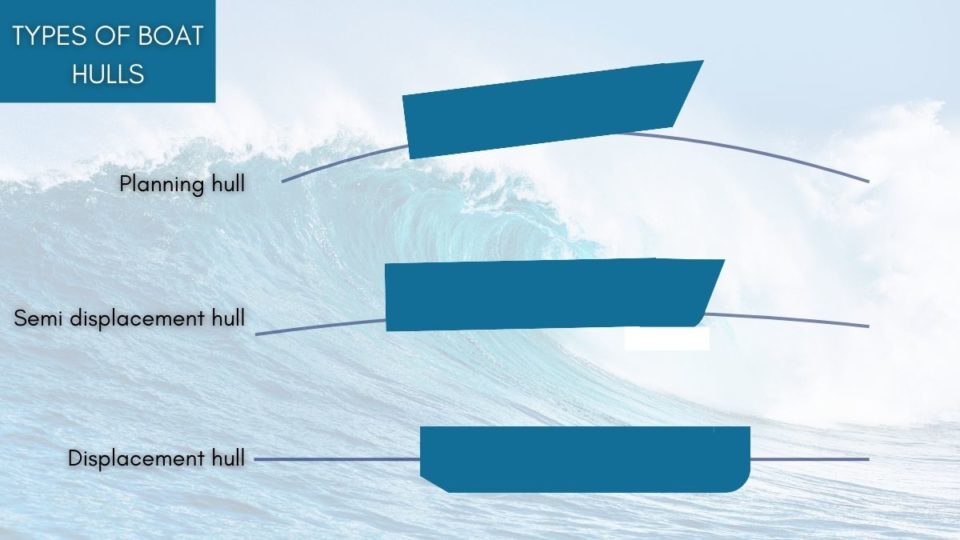
If you’ve ever watched a motorboat idle out of a slip, then open up the throttle and shoot off at high speed as soon as it’s clear of the docks, you’ve seen every type of hull form in action. When it’s moving slowly, it is displacing the surrounding water. As the throttle increases, the bow rises, the stern squats and makes a bigger wake, and the boat speeds up. And finally, the boat flattens out as the engine increases pitch and speeds up even more. The boat is now planing, and reaching its maximum speed. Most hulls operate in one mode or the other, though some operate in that semi-planing (or “semi-displacement”) mode between the two.
Important note: there can be confusion about hull shapes in marketing materials, and there will be words and descriptions on sales materials which use combinations of displacement, planing, and semi-planing, sometimes interchangeably. For instance, the sales materials may describe a semi-planing yacht as “planing,” and it will reach impressive speeds. Over a certain size, the line blurs on planing, so it’s not necessarily deceptive. So read carefully, check the performance specs, and ask lots of questions.
Displacement hulls
A moving boat makes a bow wave. As wavelengths increase, so does the speed of the wave, and a faster moving boat makes a longer wave. But without extra power, a displacement hull can not escape the top of the wave, and a boat can not make a wave longer than its waterline. Therefore, a displacement hull cannot exceed the speed of the largest wave it can create, which the waterline determines. The theoretical maximum speed of a displacement hull is 1.34 times the square root of its load waterline length (LWL).
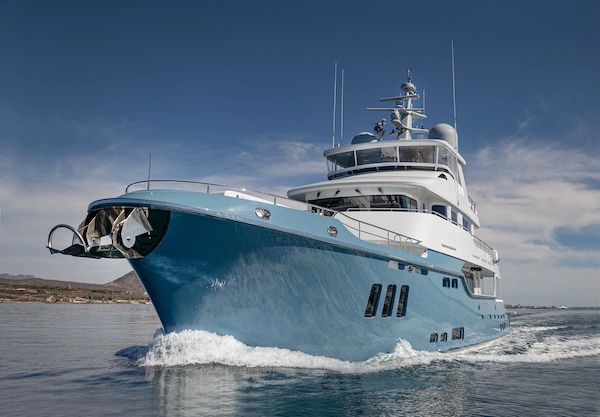
To get out of displacement mode and escape that speed limit requires much power or some sort of edge. Most sailboat engines don’t have that kind of power, nor do displacement power yachts like trawlers. Running the engines at high speed burns more fuel and makes more noise, but doesn’t move the boat appreciably faster. Putting a bigger engine won’t move the boat much faster either, since the hull is not designed for it.
Displacement mode sailing is the design choice for most cruising boats and many power yachts, so they rarely break out of that wave. Trawlers, tugs, and many heavier cruising sailboats are examples of displacement hulls. Displacement hulls are typically fuller and more rounded, with high interior volumes and space for their length. They are also often heavy.
Planing hulls
The fastest power boats and yachts are planing boats. Once a boat is on a plane, more throttle increases speed, and boats can get quite fast. But a planing hull has limitations. To get a boat on a plane, one must keep the weight low unless the engine power is really high. The hull needs a certain shape, usually flatter and more shallow running aft, with a sharper entry on the bow. The hull is often v-shaped on power boats.
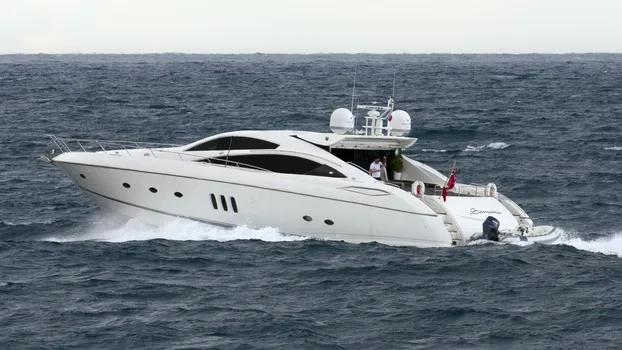
Powering on a plane is quick, but at a cost. The upper limit on speed is how much power the engine can deliver, but getting the boat up out of that bow wake takes a lot of power too. And keeping a boat on a plane means keeping the throttle on and the fuel consumption up. You’ll get there faster, but it will take more fuel per mile.
Some sailboats can sail on a plane. These are lightweight, high-performance racing yachts, with enormous sail area and a hull form designed for planing. They can’t plane under power, but in the right wind conditions they will take off and fly.
Smaller powerboats like dinghies, personal watercraft, center console fishing boats, and ski boats have planing hulls. There are also large yachts and military vessels with enough power to get a hull over 40m up on a plane and keep it there.
Some planing boats can get very uncomfortable in heavy seas, as they can not safely maintain the speed needed to stay on a plane with large waves.
Semi-displacement hulls
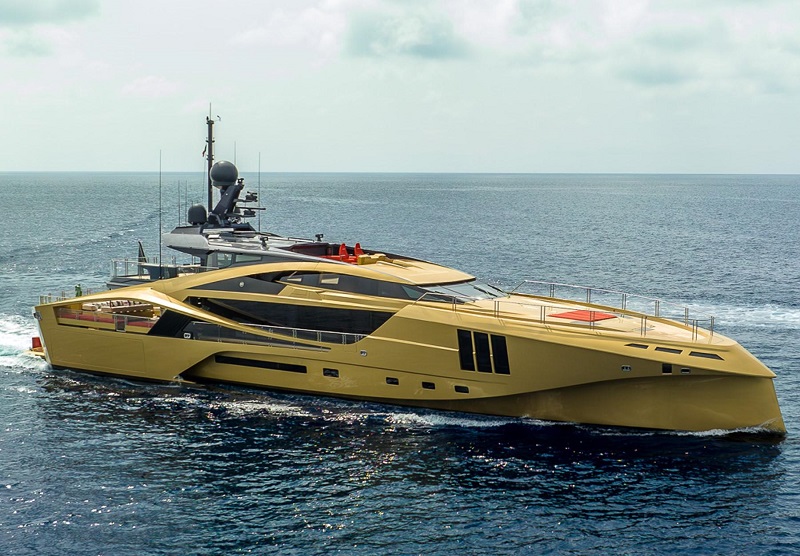
The semi-displacement (also called semi-planing) hull is a popular compromise for larger cruising yachts. They typically have a fuller stern, like a displacement hull, but a sharpened entry with a V-form at the bow. The engines have enough power to get the front section of the boat up and out of the water, but not get on a true high-speed plane. This increases speed, while still allowing for decent operation in heavier seas and waves.
They’re an excellent tradeoff for boat owners who want something a little faster, but without the same weight restriction and engine and fuel demands as a full planing boat.
Hydrofoils and the future of speed
The common feature of all these hull forms is drag, and if you take the hull out of the water, you reduce most of it. The newest high performance racing boats use hydrofoils, which lift the entire hull out of the water as the boat speeds up. Modern performance sailing vessels on hydrofoils have achieved speeds over 60 knots, and it’s only a matter of time before foiling technology regularly extends outside performance racing.
Read also: Luxury Yachts for Charter Perfectly Suited for 10 Guests
Displacement, or weight of the yacht
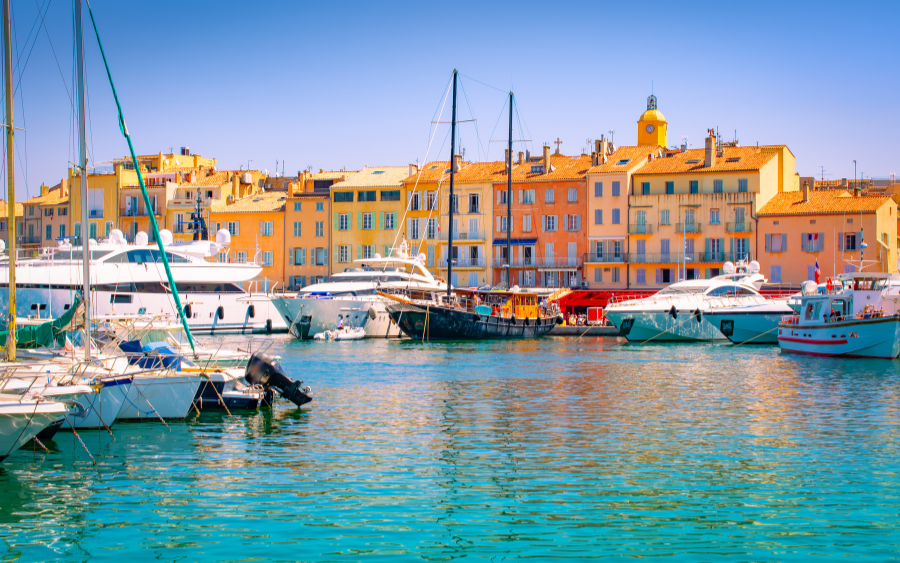
The displacement of a yacht is effectively the same as its weight. And basic physics dictates the relationship between weight, power, and speed. When applying the same force to two objects, the lighter object will move faster.
Picture two forty-foot boats, but one weighs twice as much as the other. If they have the same engines, the heavier boat will be much slower. The relationship between power, displacement and speed is complex, but a good rule is that the lighter a boat, the easier it is to make it go faster.
Yacht builders use the latest in materials technology and techniques to build the lightest, strongest hulls for performance yachts. Whether building from composites like fiberglass, or metals like aluminum, material weight is a critical choice in a boat’s build. And it’s not always materials that make the differences, but the techniques used in the build to keep weight down. The lightest, strongest materials can be expensive, as are skilled workers, so you will pay more for a light, faster boat.
Hydrodynamics – sleek means speed
The shape of a boat as it moves through the water dramatically affects its top speed. A long, thin hull form will move more quickly than a broad hull. This is what a catamaran with two narrow hulls can move more quickly that a monohull the same length. So when looking for a fast hull, longer and thinner with a narrow entry is a good sign.
The importance of drag
Drag through the water slows boats and resists forward motion. The more drag a hull has, the more force it takes to overcome. It’s like friction on a hard surface. Push a rounded shape across a smooth floor is easier than a flat box because the shape reduces friction.
In the water, many things increase the drag of a hull. The hull shape, the finish of the bottom, running gear, keels or other rough spots, and even the type and condition of the bottom paint all affect drag.
Wetted Surface
The more surface area of the yacht touching the water, the more drag from water against it. Lowering the wetted surface reduces resistance, resulting in less power needed to move the yacht. Boats of the same length but with different profiles under the water may have substantial differences in speed.
Engine power
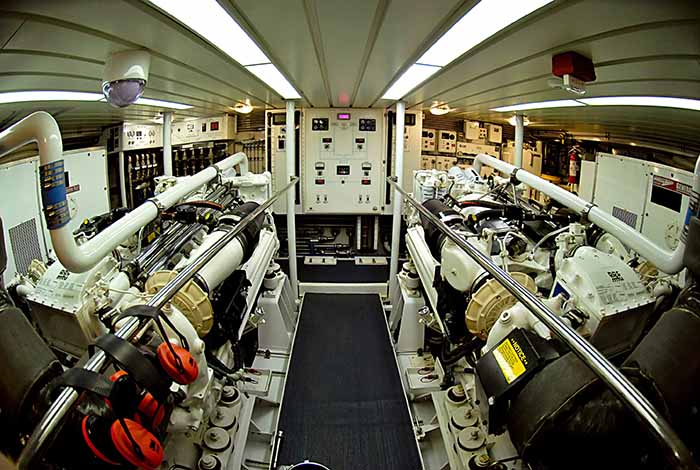
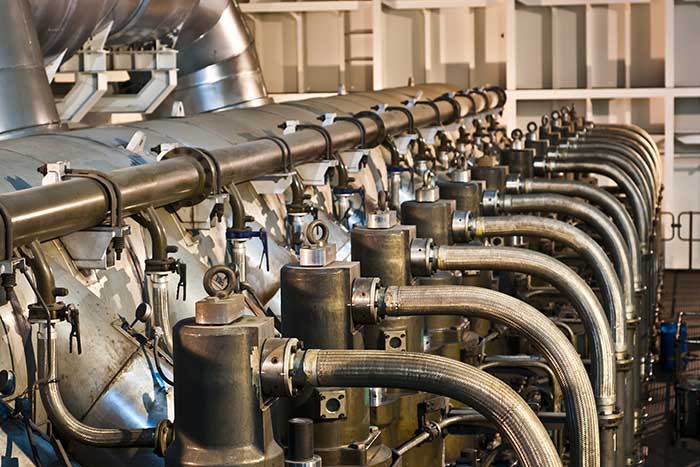
When motoring, engine power is a direct limit to yacht speed. Most times, the same hull with more engine power will move faster. But this isn’t an absolute rule, because there are limitations on hull form and shape which will top out a boat’s speed beyond a certain power. And bigger engines weigh more and use more fuel, which is heavy. It is possible to overpower a yacht, leading to wasted fuel for negligible speed gains.
Propeller pitch
The propeller acts as a screw to direct force from the engine to push the boat forward. There is tremendous variety in the design of propellers, depending on what a yacht needs. The pitch of a propeller describes the angle of attack in the water. Different angles will affect the thrusting power of the propeller, and the top end speed it can maintain. Two boats which are identical except have different propellers will have different top speeds.
This matters for all yachts, but especially those which plane. The thrust needed to get out of that hole and up on a plane ties directly to propeller design. Your propeller should have a balance of sufficient thrust to get on a plane, but it should not be pitched for so much thrusting force that you lose top end speed when you get on a plane.
Controllable, variable pitch propellers which can give good thrust for in close maneuvering, and more fuel efficiency and top end speed. They’re more complex and expensive than a fixed propeller, and may not perform as well as the fixed propeller in its ideal range. But they’re an excellent compromise for sail and motor yachts.
Sail inventory, selection, and conditions
Naval architects design a specific sail plan for a yacht, but owners usually change things. They may not have a complete inventory optimized for a full range of wind, or they may add oversized or different sails which affect a boat’s top speed. Yacht owners often optimize sail inventories for the wind conditions in their sailing area, and a suit of sails designed for a high wind area may cause slower speeds if the boat ventures beyond its home waters.
The VPP Polar Diagram gives a range of theoretical speeds for certain sails in a range of conditions, but those sails may not be available on the boat. So absolute speed comparisons again become more theoretical. But an inadequate sail inventory is easy to remedy.
Sailing stability, rig size, ballast, and draft
The size and type of rigging on a sailing yacht plays a major role in sailing ability. Tall rigs which carry a lot of sail area are faster, but besides speed, a designer chooses a rig based on handling factors and comfort.
Monohulls with deep ballast resist tipping (heeling) when the rig powers up in more wind, but other boats may power up quickly and heel in lighter wind. There’s no specific rule about the combination of rig size, keel shape, ballast, and how it relates to speed. A “stiffer” boat which resists heeling may not point as high into the wind as a more “tender” boat that heels quickly and needs crew sitting on the rail during races to stay flat.
What matters is the ability of the yacht to carry sails through a range of conditions without side-slipping, while making good progress to windwards. The designer aims for a combination of ballast and rig size that gives good speed and manageable comfort in a cruising yacht.
Wind, swell, and chop
Unfavorable wind, swell, chop, waves and current slow all boats down. But some boats are more heavily affected than others. We already discussed how planing hulls can struggle to stay on a plane in rougher conditions, but there are many other factors in sail and motor yachts which go into just how much the environment slows a boat.
Lighter boats are often slowed more by pounding into waves than heavier boats. But narrower hulls with finer entries may cut through moderate waves in conditions which slam more bluff-bowed vessels backwards. The variables are too many to lie out, but an important consideration of a yacht’s speed is how well its design handles adverse conditions.
Read also: How is a Luxury Yacht doing in Rough Seas?
Why is Speed Important?
Is it really worth it to spend a lot of money on a boat just because it’s a little faster? What’s so important about speed that people push so hard to be the fastest?
Most of the answer depends on how you plan to use your boat. If you’re planning to cruise the ICW in the U.S. or the canals of Europe, speed is probably pretty low on your priority list. But for other uses outside of just racing, speed gives you several advantages.
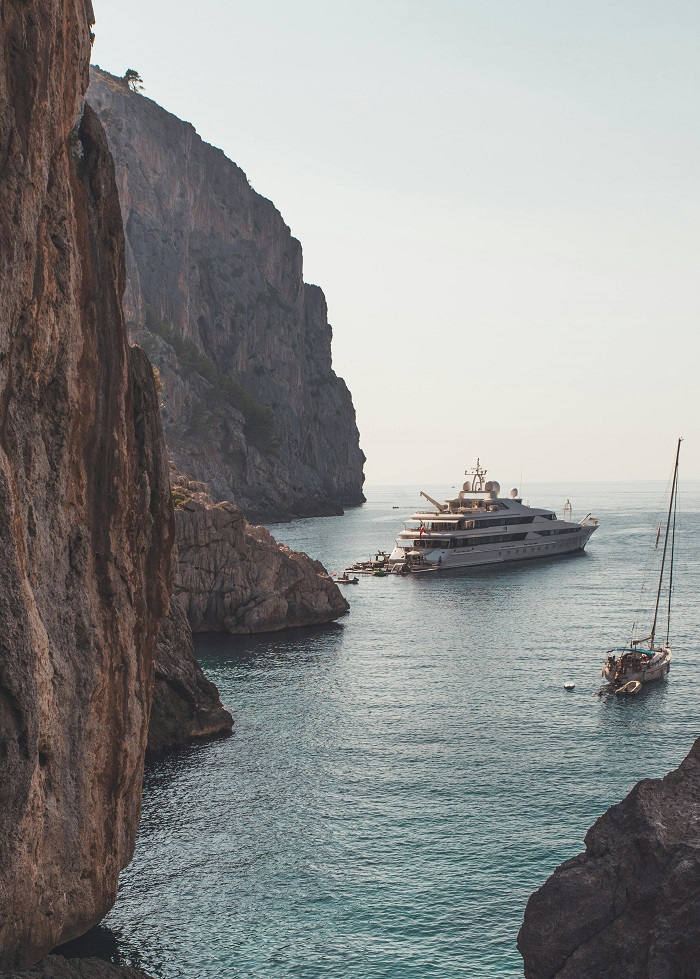
Extending your cruising range
If you cruise faster, you can cruise farther in the same time. If you have limited time on the boat and want to see more, a faster boat will allow you to extend your vacations and breaks. Covering a hundred miles in a day instead of fifty opens a lot of options for destinations.
More time at your destinations
For some it’s about the journey, for other it’s about the destination. More speed can be the difference between arriving in time for dinner versus pulling in before lunch. If you get to your destination quickly, you’ll enjoy most of another day at the beaches or in port. If you’re into maximizing what you do when you get some place, you’ll need more speed. And if you have limited time, a fast boat will get you to your destination and back within your tight window.
Safety and Weather
Avoiding heavy weather is by far the best way to handle it. A faster yacht can keep you ahead of weather systems or help you get around or in between them. To avoid foul weather, speed is one of your best safety tools.
Cruising yachts vs racing yachts
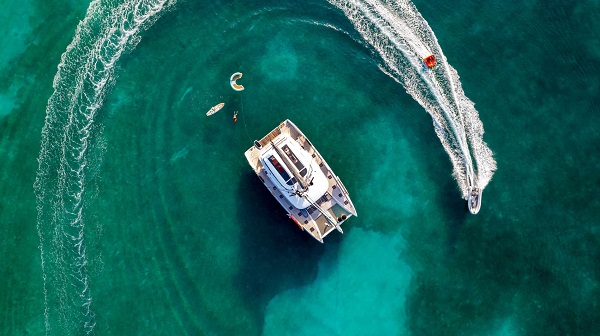
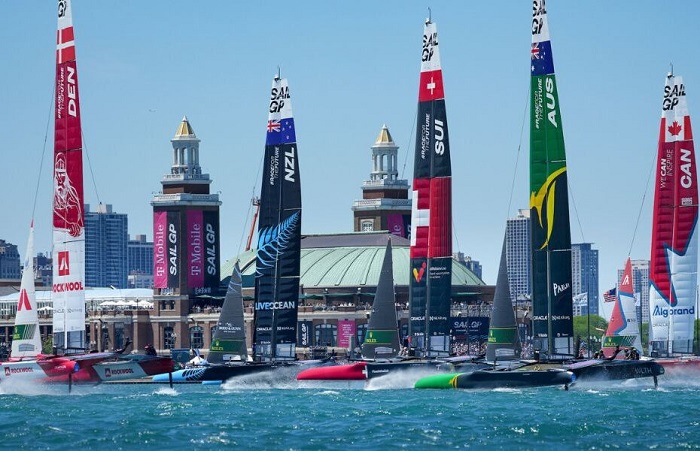
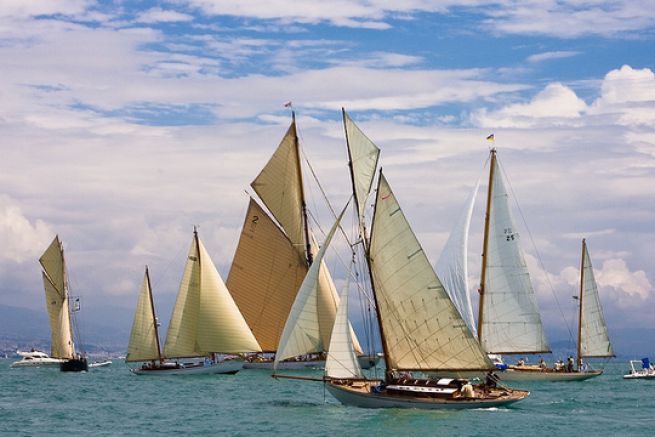
The fasted racing yachts are very specialized vessels, with minimal comforts for crew and passengers. All out speed is the priority, and everything else is secondary. Those sailors breaking 60 knots on their foiling boats? There’s no down below space, and they’re wearing helmets and padded protection when they sail.
What most people are interested in are pleasure yachts they can stay on and take places. And there is a broad range of cruising vessel styles, from slow displacement boats to performance cruising yachts which maintain planing speeds on crossings. We will not focus on the extreme racing speedsters, but on cruising yachts to travel in comfort.
Most common maximum speed by type of cruising yacht
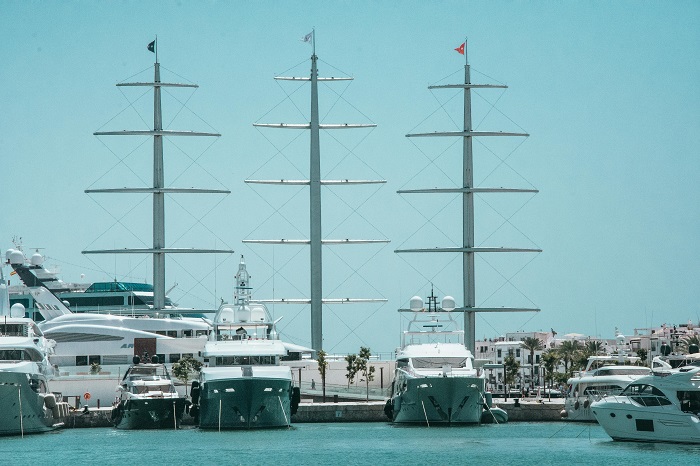
This table summarizes popular cruising yacht sizes and avoids all the high performance outliers from the racing world. These figures are average representations, and highlight the brands to look for when you want a faster boat.
Keep in mind all we’ve discussed on what speed numbers mean and understand that the maximum speed for a yacht may well exceed the designer’s expectations in the right conditions. Sailing speeds are at optimal wind and wave conditions and may not be sustained speeds over long periods.
Note that brands and builders are representative and not necessarily an endorsement. There are many examples of top performing yachts from a wide variety of builders, and these names are a starting point for your search.
| Type of boat | Cruising speeds | Maximum speeds | Extreme speeds | Performance Builders and Brands |
| Sailing monohulls | ||||
| From 11 to 15 meters (36′-49′) | 6-8 knots | 10-12 knots | 15+ knots | J Boats X-Yachts Pogo |
| above 15 meters (50’+) | 7-9 knots | 12-15 knots | 16+ knots | Swan Beneteau First Yacht Solaris |
| Sailing catamarans | ||||
| from 11 to 14 meters (36′-46′) | 8-12 knots | 20 knots | 30+ knots | Outremer TS |
| Above 14 meters (50’+) | 10-15 knots | 25+ knots | 35 Knots | Gunboat Outremer HH Catamarans |
| Power catamarans | ||||
| From 11 to 14 meters (36′-46′) | 16-18 knots | 23 knots | 35-42 knots | Arrowcat Aquila |
| Above 14 meters (47’+) | 16-18 knots | 25 knots | 30-35 knots | Infiniti Archipelago |
| Motor yachts – Displacement | ||||
| From 11m to 16m (36′-52′) | 6-9 knots | 9-12 knots | N/A | Nordhavn Krogen |
| Between 16m and 24 m (53′-79′) | 7-10 knots | 10-13 knots | N/A | Nordhavn Krogen |
| Motor yachts – Semi-Displacement | ||||
| From 11m to 16m (36′-52′) | 8-10 knots | 16-18 knots | 26 knots | Beneteau Swift Trawler Viking |
| Between 16m and 24 m (53′-79′) | 8-10 Knots | 18-25 knots | 33 knots | Grand Banks Viking Van der Valk |
| Motor yachts – Planing | ||||
| From 11m to 16m (36′-52′) | 20-30 knots | 35-40 knots | 48+ knots | Magnum De Antonio CNM |
| Between 16m and 24 m (53′-79′) | 20-30 knots | 35-40 knots | 58+ knots | Sunseeker Magnum Maori |
| Superyachts (24+ meters, 80+ feet) | ||||
| Displacement | 8-12 knots | 14 knots | 20+ knots | Sunseeker |
| Semi-displacement | 10-14 knots | 22 knots | 26+ knots | Ocean Alexander Sunseeker |
| Planing | 20 knots | 28-30 knots | 70+ knots | Bolide |
| Megayachts (30.5+ M, 100’+) | ||||
| Displacement | 9-14 knots | 18 knots | 20+ knots | Sunseeker Dynamiq |
| Semi-displacement | 10-15 knots | 20 knots | 28-32 knots | Jongert Palmer Johnson |
| Planing | 12-18 knots | 22-25 knots | 35-70 knots | Heesen Fincantieri Millenium |
Chartering a Fast Yacht
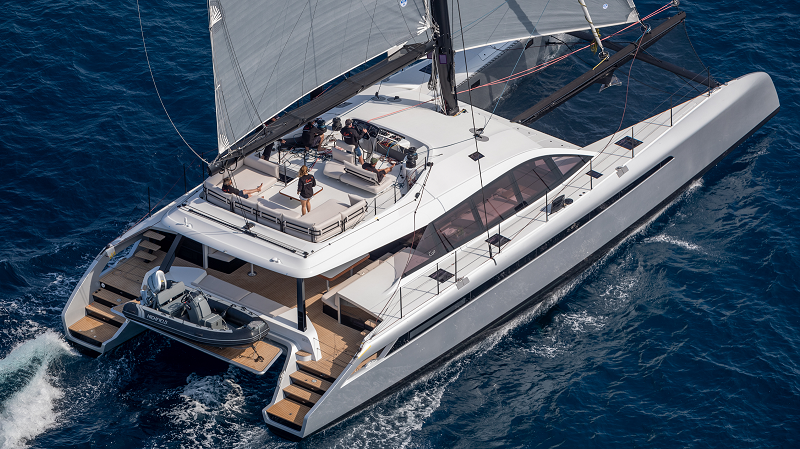
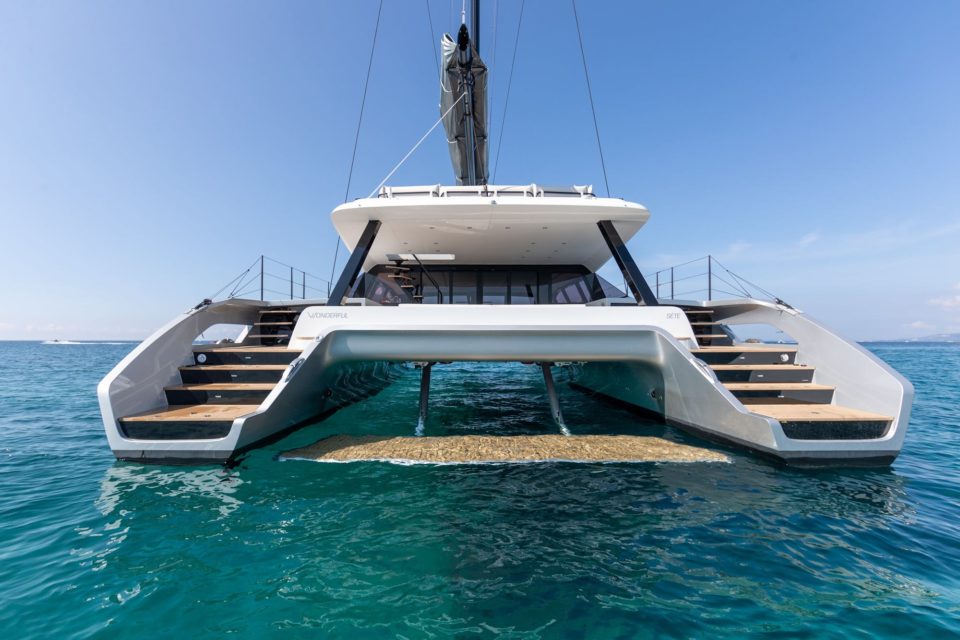

Chartering a fast yacht can give you incomparable vacation memories. In a brief time, you can see a lot of different ports and anchorages and sail a rich itinerary with a lot of variety. Speed makes the most sense where there’s a lot of water to cover, and many destinations with some distance between them.
Pick a quick yacht with an experienced captain
To get the most out of a fast charter yacht, use a captain who knows the waters and how to get the most out of the vessel. Faster vessels are a little trickier to sail and run at their optimal speeds. Experience helps, so you don’t have to worry about being on a fast boat which you can’t get moving the way you expected. And an experienced captain will also know the best routes and ports for the weather and the capabilities of the yacht.
Sail in windy destinations
A fast sailing yacht will sail reasonably quickly, even in light air. But if you’re feeling the need for speed, why would you want to charter where there’s no wind? Part of the fun of chartering a fast yacht is sailing it fast, and where is the best place to do that but places with open waters and lots of reliable breeze? Make sure you’re pairing your fast boat with consistent winds for the best sailing charter.
If you’re planning a motor yacht charter, you might prefer destinations with less wind. You’ll motor faster and the boat will be more comfortable.
Fast yachts may trade comfort for speed
From everything we discussed on yacht design and speed, it’s clear everything is a compromise. And building a yacht for speed may mean sacrifices, like narrower hulls, less furniture, smaller tankage, and other tradeoffs to keep weight down and the hull sleek for speed.
Do not assume that a fast yacht will lack comfort or feel cramped. You’re hiring or buying a luxury yacht, and you will have plenty of comforts. But to get more speed, compared to slower boats the same size, it may have a lower capacity for guests, cargo and water toys, and have some reduced comfort systems to keep the weight down.
Fast sailing yachts available for charter
Our company has the first Gunboat 72 catamaran open for charter. Gunboat has earned a reputation as a premier brand for speed and comfort in sailing catamarans. And the Gunboat 72 is no slouch for speed or comfort. With four cabins for eight guests, her crew of three will keep you well and have you flying at speeds over twenty knots under sail.
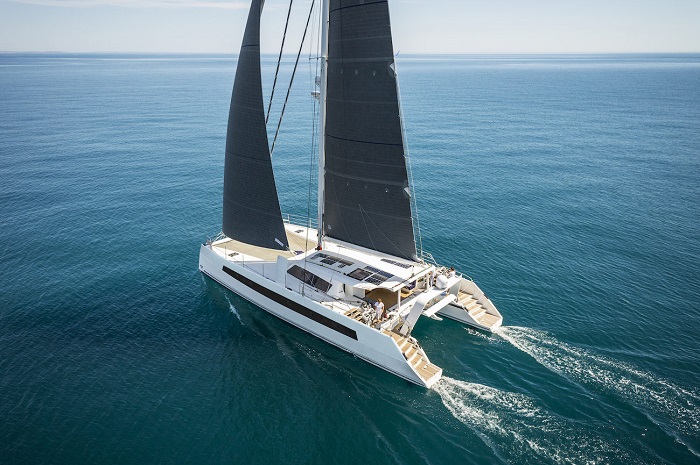
The Catana 70 NEPTUNE exceeds all expectations; an exceptional model with a sleek profile and racy lines. The combination of technical excellence, and a design and performance which is constantly being advanced. A luxury interior which is both refined and functional, minute attention to the smallest of details, exquisite materials, all to offer a way of life on board a yacht without limits. The jewel in the crown of the Catana yard, the Catana 70 will seduce the sportsmen looking for feel and adrenaline, as much as the connoisseurs looking to embark on a long trip in total refinement. Offering even more living space than all the other models, the Catana 70 has spacious cabins as well as many lockers and storage areas ensuring optimal conditions for a long trip.
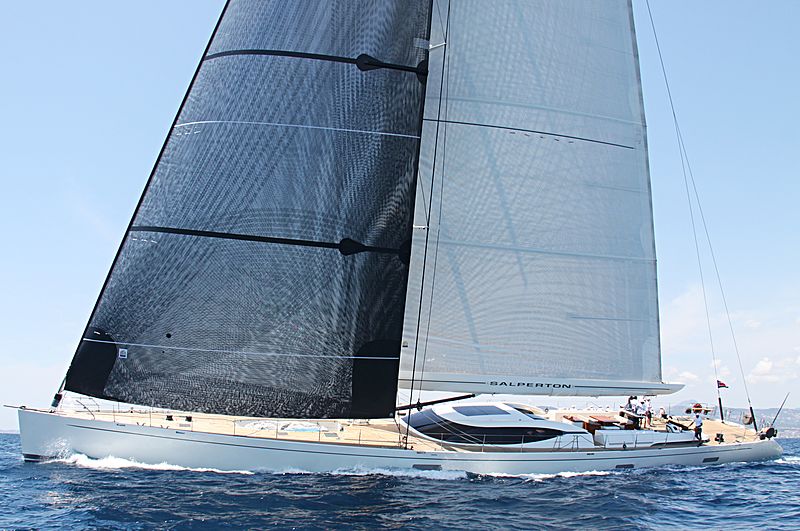
The unique design of Mes Amis allows the transom to open into a versatile swim or boarding platform, creating a seamless connection between the yacht and the pristine waters it navigates. From the expansive cockpit through the saloon to the lowered dining area, she provides an unparalleled space for entertaining, ensuring that every moment on board is a celebration of sophistication.
Fast motor yachts available for charter
This sumptuous Sunseeker Quantum sports boat is where the party is throughout the Adriatic summer, with her elegant luxury looks backed up with raw power and performance. This flagship Predator 108 confidently violates all the norms, with luxuries often seen on a much bigger yacht, such as a Jacuzzi, huge aft deck with bar, and state-of-the-art audio-visual system. QUANTUM’s accommodations are likewise top-notch, accommodating up to 9 passengers in four luxurious ensuite cabins, including a master bedroom with walk-in closet and steam shower.
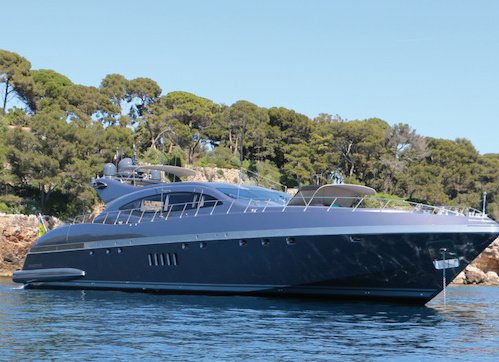
Prepare to embark on a journey of unparalleled luxury aboard this stunning Mangusta, a vessel that promises to redefine the meaning of opulent holidays. Originally built in 2001 and subsequently treated to major refurbishments in 2015 and 2020, JFF is a true masterpiece of the seas, offering the ultimate in stylish cruising. Whether your heart yearns for an exclusive voyage to Saint Tropez or an invigorating escapade to Corsica or Sardinia, this lavish Mangusta 108 is your ticket to unforgettable experiences.
As you step onto JFF’s pristine decks, you’ll be greeted by an ambiance that exudes grace and sophistication. With accommodations for up to 8 guests across three sumptuous staterooms—an extravagant Master cabin, a VIP cabin, and a generously appointed double cabin—you’ll find yourself immersed in an environment that seamlessly marries modernity with refined elegance.
Study Well, Book or Buy Well
When choosing a charter, if you pick a boat which isn’t quite what you want, well, you haven’t completely wasted your charter money. It just won’t be what you hire next time. But you don’t want to be disappointed, because the cost is your time and your charter fees.
And buying is a bigger commitment, so you want to understand what you’re buying and that you’re buying what you truly want and need.
And that is the big question – what yacht suits your requirements? Only you can answer the balance of speed, comfort, and economy which works best. Hopefully, we’ve given you a few tools to ask the right questions.
Read also: Beginner’s Guide To Chartering: Everything You Need To Know




